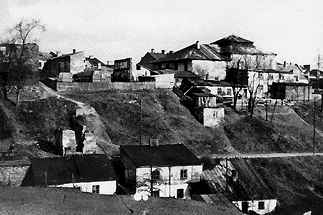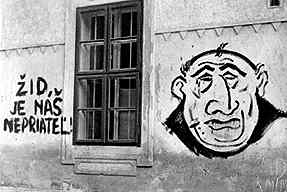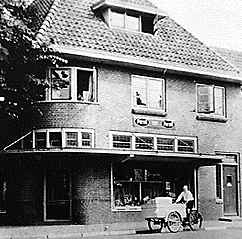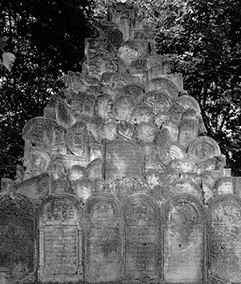Jews were forced to wear.
From To Save a Life.
| The Journal for MultiMediaHistory Volume 1 Number 1 ~ Fall 1998 |
To Save a Life: Stories of Jewish Rescue. Ellen Land-Weber. Produced by Ellen Land-Weber, 1998. CD-ROM, based on the Web site of the same name: http://www.humboldt.edu/~rescuers.
|
|
Jews were forced to wear. From To Save a Life. |
 |
From To Save a Life. |
 |
Our Enemy." From To Save a Life. |
Land-Weber�s inclusion of multiple and overlapping stories offers a subtle understanding of the ambiguous relationships between rescuers and rescued. After surviving the Nazi genocide as a cook in a school, Olga Lilien stayed in the village of Tarnobrzeg, working as a pediatrician until her death at age 92 in 1996. She remembered the villagers� refusal�despite their own hardship�to betray her to the Germans. On the other hand, Rachel Litowicz recalled the residents of Sandomierz and other Poles were hostile to Jews. Litowicz also recounted her brief and unhappy return to Sandomierz after the war when she encountered continued antisemitism. The Szymanskas, she concluded, were "angels" and "aristocrats," but "the rest are [emphasis added] not like that."
Some rescuers and rescued Jews never developed cordial relationships. Bert Bochove hid a wealthy German Jewish banker, but "the big, self-confident man" irritated others and had to be moved to another hiding place over a grocery store. Here he would have suffered starvation at the hands of his Christian keepers if not for the sandwiches he received from Bochove. One teenaged boy rescued by Tina Strobos irritated his hosts with his rebelliousness and foot odor! Barbara Szymanska once harbored a girl named Sophie. After the war she later learned Sophie was living near her in Canada. She sent a letter, but Sophie wrote back dismissing the rescue work and refusing to pay any (unrequested) reward money!
 |
From To Save a Life. |
Unfortunately the absence of narrative or analytical structure in the CD-ROM leaves the user without a clear interpretation of rescuers and their efforts. In a rare instance of analysis by a rescuer, Bochove, who operated a pharmacy in Huizen, Holland, noted that dozens of Jews were hidden by several families in his town. Why? Bochove believed that his neighbors were close to Amsterdam and consequentially had long had "a kind of relationship" with Jews. In addition, "there was the quality of the people�the most stubborn in their hate against the Nazis�and their orthodox beliefs that the Jews were God�s chosen people. They took the Bible literally." On the other hand, Bochove was not motivated by religion but a largely unexamined moral imperative to help one friend. Afterward he could not reject others, even strangers, who asked for help. His stressful and demanding work cost him his health and accelerated his wife�s demise. Bochove�s unusually reflective story echoes the findings of historians working on Le Chambon, France and other communities which rescued Jews.
 |
constructed of vandalized Jewish headstones, 1987. From To Save a Life. |
Ellen Land-Weber credits her colleagues Professors Samuel and Pearl Oliner with inspiring To Save a Life. Working as an interviewer with the Oliners on The Altruistic Personality: Rescuers of Jews in Nazi Europe (1988), Land-Weber became interested in the psyche of individual rescuers. She states that her motivation for the project was to provide "an example for others, for they prove that it is possible for ordinary people to make a difference, to act for social justice in an imperfect world." Unfortunately historians and other scholars may find the work has shortcomings. It presents the interviews largely without comment and does not consider the problematic nature of oral history. In addition, it rarely provides narrative or interpretative guidance. Consequently, there is little sense of the conflicted nature of Holocaust interpretations (as evidenced by the Goldhagen controversy) or the highly ambiguous nature of human virtue. Moreover, the material is only minimally contextualized with links to brief descriptions of the countries, sites, and conditions where rescuers worked. To Save a Life offers engrossing stories and powerful visuals that commemorate the heroism of rescuers and rescued but it should not be substituted for equally accessible but more interpretative works such as Christopher Browning�s Ordinary Men or the films Hotel Terminus and Weapons of the Spirit.
Neal R. McGrillis
Columbus State University (Columbus, GA)
~ End ~
CD-ROM Review of To Save a Life: Stories of Jewish Rescue
Copyright © 1998 by the Journal for MultiMedia History
![]()
![]() Comments
to: [email protected]
Comments
to: [email protected]
Contents:
JMMH, Volume 1 Number 1 Fall 1998